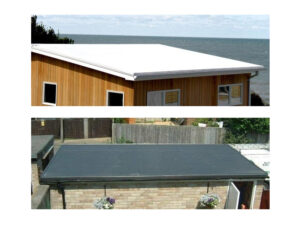
White roofs versus dark roofs? When choosing a surfacing or membrane color, there are several things to consider. White membranes, also referred to as cool roofing, use highly reflective and emissive properties generally associated with lighter colors to reflect solar radiation and, as such, emit heat to reduce roof surface temperatures. Darker membranes absorb heat from the sun, and radiate this heat to both the surrounding atmosphere and the building interior below. Since we can’t turn our roof black in the winter to absorb the heat, and white in the summer to reflect it, how do we know which roof would be better suited for our building’s overall efficiency?
During summer months, when building interiors are typically conditioned (i.e., the “cooling season”), the advantages of a cool roof in terms of cost effectiveness, are obvious – a highly reflective roof reduces heat gain by reflecting solar radiation. Reducing heat gain into the roof system will help reduce cooling costs.

This translates to a clear advantage of white roofing in southern climates where the cooling season is most prominent. In summer months, studies have shown that cool roofs can reduce surface temperatures by more than 25%. Currently, ASHRAE Standard 90.1 contains “cool roof” solar reflectance and thermal emittance provisions for Climate Zones 1-3, the warmest climate zones in the United States, but no such provisions are set for Zones 4-8 (see ASHRAE Climate Zone Map below).
North of Climate Zone 3, the debate as to the value of cool roofing continues. Some industry groups and leaders are of the opinion that dark roofing is more efficient in areas where the heating season outlasts the cooling season (due to the potential for an increase in winter heating costs produced by cool roofing). There are several, perhaps less obvious, factors that appear to limit or nullify the advantages of dark roofing in colder climates and winter months:
- Snowfall – Snow can significantly affect the thermal performance of the roof surface, not only through coverage, but also through its insulating properties. Roofs in northern climates can spend much of the winter covered in snow, which prevents the solar radiation absorptivity of a darker roof surface from being useful. Additionally, depending on its depth, fallen snow on roofs can act as an additional layer of insulation, making the roof surface color even less of a factor. As a side note, less snow melt can impact snow load, and this should be taken into consideration during the design phase.
- Solar Angle –The angle of the sun is lower during winter months and the days are shorter, particularly in norther climates. There is less total solar radiation available to be absorbed by the roof, making the benefits of a dark roof less pronounced during the winter.
- Shorter/Cloudier Days – The number of cloudy days historically increases in most northern climates during winter months. The increase in cloud cover reduces the sun’s ability to heat the roof, again diminishing the advantages of dark roofing.
- Energy Resource Costs – In most cases, heating resources like natural gas or oil are less expensive than cooling resources such as electricity, so the added winter heating costs for a cool roof make less of an impact than the added summer cooling costs for a dark roof. Additionally, most heating occurs in early morning or late evening hours, when solar radiation on the roof is low.

There are, of course, situations where cool roofing may not be a preferable option. Buildings in extremely cold climates or certain buildings where cooling is seldom (if ever) used may not draw sufficient benefits from reduced cooling costs. Cool roofing may also be at a higher risk of developing condensation beneath the membrane in consistently cold climates if the roof is inadequately insulated or ventilated.
If you have a building in a southern climate, cool roofing may reduce energy costs. Even in northern climates, a cool roof might be a worthwhile consideration.
Tagged In:
Building Enclosure Design & Consulting
